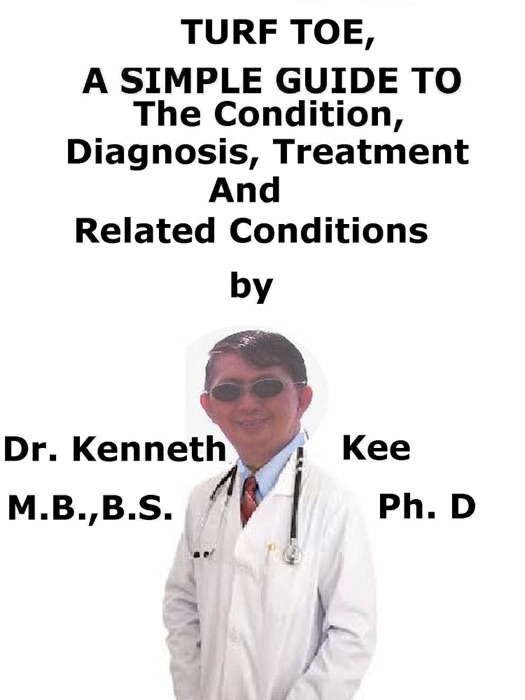(DOWNLOAD) "Turf Toe, A Simple Guide To The Condition, Diagnosis, Treatment And Related Conditions" by Kenneth Kee " eBook PDF Kindle ePub Free

eBook details
- Title: Turf Toe, A Simple Guide To The Condition, Diagnosis, Treatment And Related Conditions
- Author : Kenneth Kee
- Release Date : January 10, 2019
- Genre: Medical,Books,Professional & Technical,
- Pages : * pages
- Size : 260 KB
Description
This book describes Turf Toe, Diagnosis and Treatment and Related Diseases
Turf toe is a disorder that depicts a hyperextension injury to the plantar metatarsophalangeal-sesamoid complex of the big toe.
It is a comparatively rare and debilitating disorder, mostly seen in American footballers after the introduction of harder, artificial ‘turf’ surfaces.
Turf toe indicates a substantial injury to the hallux
If untreated, it can cause chronic disorders such as:
1. Reduced push-off strength,
2. Persistent pain,
3. Progressive deformity and
4. Eventual joint degeneration.
Patients with chronic injuries may have worse prognoses, and early, accurate diagnosis and the start of treatment play a vital part
Foot injuries were the 3rd leading cause of missed playing time and that a large part of these injuries affected the hallux MTP joint.
There has been an seemingly rise in the incidence of turf toe injuries, possibly because of the use of more flexible, lighter shoes or changes in surface–cleat interaction
Causes
The cause of injury is due to hyper-extension and axial loading of hallux metatarsophalangeal (MTP) joint when the:
1. Forefoot is fixed to the ground
2. Hallux MTP joint positioned in hyper-extension
3. Axial load is applied to the heel
The combination of force and joint positioning causes reduction or tearing of the plantar capsular-ligamentous complex
Most turf toe injuries happen due to contact with the playing surface or with another player.
This basically induces an axial load, on a hyper-extended MTP joint, with fixed equinus at the ankle.
The load forces the hallux MTP joint into hyperextension, which causes attenuation or disruption of the plantar capsular ligamentous complex supporting the joint.
The plantar plate complex is planned to oppose dorsiflexion of the first MTP joint, but these tissues can be torn, with the degree of injury dependent on the severity of injury and forces to the joint
Sesamoid injury has been said to happen alongside turf toe injury.
Sesamoids may fracture or the synchondrosis may be damaged if the sesamoids are bipartite or tripartite.
A pre-existing bipartite sesamoid bone may predetermine the patient to this trauma after frequent high intensity stresses.
The tear of the plantar capsular-ligamentous complex happens off the proximal phalanx, not the metatarsal bone.
Related injuries that happens together with Turf toe are
1. Varus, valgus injuries to hallux MTP
2. Sesamoid fracture
3. Proximal migration of sesamoid
4. Cartilaginous injury or loose body in hallux MTP joint
5. Stress fracture of proximal phalanx
6. Hallux rigidus (late sequelae)
Symptoms
The patient will manifest with:
1. Acute pain
2. Stiffness
3. Swelling of the MTP joint
They may complain of:
1. Weakness in push-off.
2. Reduced agility
Diagnosis
Standard weight-bearing AP, lateral and sesamoid axial radiographs should be taken.
The bony structures in the radiographs are often normal.
A small piece of bone from the proximal phalanx or distal sesamoid may suggest a capsular interruption or avulsion.
MRI is a helpful and accurate tool for evaluating plantar plate injuries
Treatment
Non-operative methods are indicated in most injuries:
1. Early icing and rest
2. Taping not indicated in acute phase due to vascular compromise with swelling
3. Stiff-sole shoe or rocker bottom sole help to limit motion
4. More severe injuries may need walker boot or short leg cast for 2-6 weeks
5. Physiotherapy
6. Progressive movement once the injury is stable
Surgical treatment
Less than 2% of turf toe injuries require operative intervention
A lateral release can be done to balance the hallux MTP joint
Part of the fractured sesamoid should be preserved if possible
TABLE OF CONTENT
Introduction
Chapter 1 Turf Toe
Chapter 2 Causes
Chapter 3 Symptoms
Chapter 4 Diagnosis
Chapter 5 Treatment
Chapter 6 Prognosis
Chapter 7 Hallux Valgus
Chapter 8 Hammer Toes
Epilogue